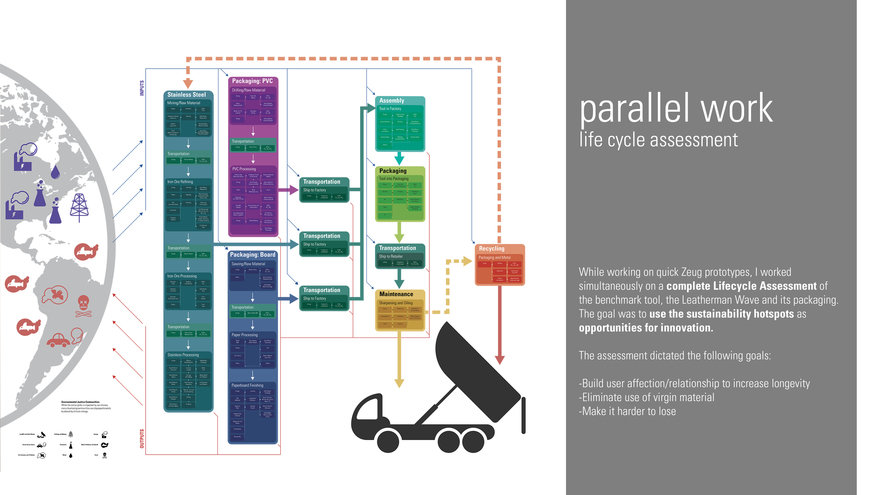Student Notable
Tools & Work Award
Core77 Design Awards 2019
Zeug
Zeug is a sustainable multitool whose geometry affords many functions. Zeug fills in the gap between no tool and an over-specialized tool. It is the everyday, every-person tool that does the jobs that other tools overlook. The simple, three-piece design makes it easy and inexpensive to manufacture, maintain and recycle.







The design brief given was to explore the meaning of "personal" and "essential" through the lens of living sustainably in the modern world. For me, thinking about personal and essential led to everyday carry items like multitools and the trends towards "Maker Culture" and favoring physical experiences over digital ones. My challenge was to design something helpful to a wide variety of projects and needs while incorporating sustainable practices and strategies as tools for ideation and innovation.
The particular advantage of this design is its simplicity. Zeug is made from steel. A single material product with no small parts to get lost or broken ensures easy manufacturing and maintenance. Other metals, like aluminum, do not hold up to all use-cases and are subject to bending or breaking. Also, other materials considered were too costly or difficult to recycle. While steel does add additional weight, this heft imparts the tool with a confident, quality feeling, which also helps to build preference with the user. The simple design and ease of maintenance also mean that the tool will retain its usefulness, unlike other tools that dull or wear.
There is no wrong way to use Zeug. Its shape and configuration are easy to understand and manipulate, allowing Zeug to be adapted based on the user's imagination.
Inspired in part by artist Richard Serra's Verb List (1968), Zeug can be used to crease, pry, wedge, hammer, spread, crush and more. Zeug also is designed to embrace wear and tear, thereby changing our relationship with disposable commodities. The scratches, scuffs, and patina that a tool accumulates represent stories, badges of accomplishment, and bonds with the user rather than unsightly blemishes that would typically result in the discarding of a tool.
With only three steel pieces and three screws, the design of Zeug considers Design for Manufacturing and Assembly in keeping parts and processes to a minimum. Fewer parts mean that the tool is easy to produce and less costly to manufacture. Zeug is also a low-cost entry for a tool brand to take a public stance on sustainability, product longevity, and other corporate values.
Zeug is also designed to extend the traditional lifecycle beyond that of a typical tool. It removes features that might break, dull or not be used. It is designed with fiddling and fidgeting in mind; increased tactile interaction builds affection for Zeug, which in turn enhances the user's commitment to keep and use it. If it does end up in an end-of-life scenario, Zeug is designed to skip the landfill entirely. Since Zeug is made from one material, discarded tools can be easily identified and separated for steel recycling.
Zeug is made from steel. Other metals, like aluminum, do not hold up to all use-cases and are subject to bending or breaking. Also, other materials considered were too costly or difficult to recycle. While steel does add additional weight, this heft imparts the tool with a confident, quality feeling, which also helps to build preference with the user.
The product is 5 inches long,1.25 inches wide and 0.375 inch deep. It weighs approximately 7 ounces, equivalent to comparable multi-use pocket tools, and the retail cost of Zeug is 50 dollars.
Core77 Design Awards 2019
- Built Environment
- Commercial Equipment
- Consumer Technology
- Crowdfunding
- Design Education Initiative
- Design for Social Impact
- Furniture & Lighting
- Health & Wellness
- Home & Living
- Interaction
- Packaging
- Personal Accessory
- Service Design
- Speculative Design
- Sports & Recreation
- Strategy & Research
- Tools & Work
- Transportation
- Visual Communication